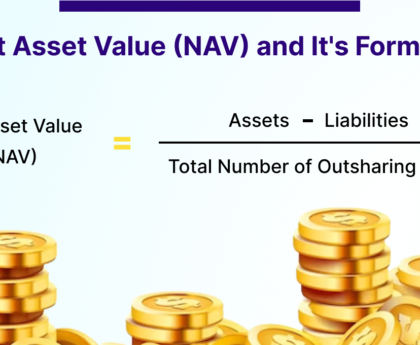With so many investment plans out there, one is indeed to get confused. Choosing the right investment plan based on your needs is necessary to grow our money, and achieve the goals that we aim for. We all have heard about Mutual Funds- Sahi hai! But today we are going to compare mutual funds with another investment option ULIP- Unit Linked Insurance Plan. We will compare both the plans in detail and help you understand which plan is better suited for you based on your needs.
What is ULIP?
ULIP- Unit Linked Insurance Plan, is a policy offered by insurance companies. Unlike a regular insurance policy, provide an integrated plan of both an insurance as well as an investment option. The amount of premium is divided into 2 parts, one is used to provide insurance coverage to the policyholder and the remaining portion is invested, the amount may be usually invested in equity and debt instruments, and the ratio of an investment may be different depending on your provider and plan. Similar to Mutual Fund, the amount from all the policyholders are pooled together and then invested in various securities, such as equity and debt. The policyholders even have an option to select personalized investments based on their investment needs and risk-bearing capacity.
Types – Usually, the ULIP scheme has 2 different options, under type-1, the nominee gets the higher sum assured and fund value. While under type-2, the nominee gets the sum assured and finds value in case of the demise of the policyholder. Your plan type-1 or Type-2 depends on your plan and your company and you may enquire about it before investing.
Charges- ULIP also has a list of charges that are to be paid by policyholders:
1. policy administration charges
2. premium allocation charges
3. fund switching charges
4. mortality charges
5. policy surrender or withdrawal charge
Risks-
As the policyholder’s money is invested in the market, the risk of the market is also associated with the investment and is borne entirely by the policyholder. One may read all investment-related documents carefully, and invest in plans which match their risk-bearing capacity.
What are Mutual Funds?
A Mutual Fund is a professionally managed fund, where money is pooled from several investors to invest in Securities. Mutual funds are usually distinguished based on their principal investment. Such as Money market funds, bonds or fixed-income funds, and equity funds. They may have a combination of some of them, which is known as a hybrid fund. Also, you get a wide variety of options while investing in mutual funds as there are Mutual funds based on an index known as an index fund, you also find mutual funds that are based on a certain sector. The person who manages the Mutual fund is known as the fund manager. The average return on mutual funds falls somewhere between 8-12%. But some may go as high as 30-35% if you’re lucky enough. The main advantages of the mutual fund include low risk, professional management, and diversification. A mutual fund is increasingly becoming a favored choice of investors as it doesn’t require much time to research, you just have to find a good fund and you start with as low as ₹100 with SIP.
Types- Mutual funds are usually of two types, open-ended funds, and close-ended funds.
Charges-
1. Management fee
2. Distribution charges
3. Securities transaction fees incurred by the fund
4. Shareholder transaction fees
5. Fund services charges
Risks- The risk under Mutual funds is certainly less as compared to other investment options such as direct equity investment. Also as the fund is professionally managed it makes it even more secure.
Conclusion- We have explained everything about ULIP as well as Mutual funds. I hope the article was able to help you understand both and choose the right one for you. Based on your risk capacity and investment capital you may choose the one that suits you.
What is ULIP?
ULIP- Unit Linked Insurance Plan, is a policy offered by insurance companies. Unlike a regular insurance policy, provide an integrated plan of both an insurance as well as an investment option. The amount of premium is divided into 2 parts, one is used to provide insurance coverage to the policyholder and the remaining portion is invested, the amount may be usually invested in equity and debt instruments, and the ratio of an investment may be different depending on your provider and plan. Similar to Mutual Fund, the amount from all the policyholders are pooled together and then invested in various securities, such as equity and debt. The policyholders even have an option to select personalized investments based on their investment needs and risk-bearing capacity.
Types – Usually, the ULIP scheme has 2 different options, under type-1, the nominee gets the higher sum assured and fund value. While under type-2, the nominee gets the sum assured and finds value in case of the demise of the policyholder. Your plan type-1 or Type-2 depends on your plan and your company and you may enquire about it before investing.
Charges- ULIP also has a list of charges that are to be paid by policyholders:
1. policy administration charges
2. premium allocation charges
3. fund switching charges
4. mortality charges
5. policy surrender or withdrawal charge
Risks-
As the policyholder’s money is invested in the market, the risk of the market is also associated with the investment and is borne entirely by the policyholder. One may read all investment-related documents carefully, and invest in plans which match their risk-bearing capacity.
What are Mutual Funds?
A Mutual Fund is a professionally managed fund, where money is pooled from several investors to invest in Securities. Mutual funds are usually distinguished based on their principal investment. Such as Money market funds, bonds or fixed-income funds, and equity funds. They may have a combination of some of them, which is known as a hybrid fund. Also, you get a wide variety of options while investing in mutual funds as there are Mutual funds based on an index known as an index fund, you also find mutual funds that are based on a certain sector. The person who manages the Mutual fund is known as the fund manager. The average return on mutual funds falls somewhere between 8-12%. But some may go as high as 30-35% if you’re lucky enough. The main advantages of the mutual fund include low risk, professional management, and diversification. A mutual fund is increasingly becoming a favored choice of investors as it doesn’t require much time to research, you just have to find a good fund and you start with as low as ₹100 with SIP.
Types- Mutual funds are usually of two types, open-ended funds, and close-ended funds.
Charges-
1. Management fee
2. Distribution charges
3. Securities transaction fees incurred by the fund
4. Shareholder transaction fees
5. Fund services charges
Risks- The risk under Mutual funds is certainly less as compared to other investment options such as direct equity investment. Also as the fund is professionally managed it makes it even more secure.
Conclusion- We have explained everything about ULIP as well as Mutual funds. I hope the article was able to help you understand both and choose the right one for you. Based on your risk capacity and investment capital you may choose the one that suits you.

